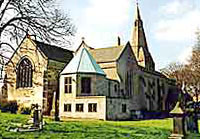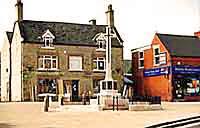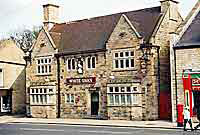Bolsover is situated seven miles east of Chesterfield in Derbyshire, off the A632 road.
The approach from the north and the east is dominated by Bolsover's famous 17th century castle, built by the Cavendish family and visited by thousands of people each year. See Bolsover Castle.
Across the main road from the castle is
a public house called the Hudson Bay, originally built as a house for
his mother by Peter Fidler, a local lad who worked for the Hudson Bay
Company in the 18th century as a surveyor. A thriving Peter Fidler
Society still exists in Canada.
Much evidence of hundred years of coal-mining remain, including a magnificent model village
for the miners. Craftsman-built, solid family houses surround a vast
attractive green giving light and spaciousness to the occupants.
Behind Sherwood Lodge is evidence of prehistoric habitation in Bolsover. Here are the remains of an Iron Age entrenchment which would
have encircled the settlement, protecting its people from attack. This
leads to an open space known today at Kitchin Croft, named after John
Kitchin, a clay pipe maker of 1739. Pieces of clay pipe are still found and
are known al fairy pipes, legend being that they were used by fairies under the earth.
This area must have been a hive of industry in the 17th and 18th
centuries as blacksmiths and potters also practised their crafts here. A more
unusual industry was that of making iron shoe buckles which were once quite famous . The local colliery closed in 1993. It's demise is represented at Bolsover Gateway by a gleaming metal sculpture of a fractured winding wheel. More recently the large Coalite plant has also closed. However Bolsover is attracting new residents, not only because it is no longer scarred by soot - black spoil heaps, but because it stands conviently close to the M1.

Bolsover church |

Bolsover memorial cross |

White Swan pub |
Bolsover boasts many old public houses of which the White Swan
doubled as the moot court from the Middle Ages until nearly the early 19th
century. Bolsover received its market charter from Henry 111 in 1225,and
the original grid pattern of streets is still discernible. On High Street
today if you look carefully, clues to Bolsover's long association with
agriculture can be seen. One or two typical 17th century farmhouses are
still standing, plus a barn now used by the Catholic church. Other such
buildings can be spotted, disguised behind picture windows and modern
doors.
The church of St Laurence, with its 13th century tower, is situated at the end
of High Street. Inside is the
Cavendish chapel, which holds many monuments to the Cavendish family including the tomb of Charles Cavendish, son of the
indomitable Bess of Hardwick, and his wife. At the foot of the steps to
the chapel and in direct contrast to the sumptuousness of the Cavendish
memorial, is a rough stone in memory of Huntingdon Smithson and his
son, John, who were the architects of Bolsover Castle. The church was largely destroyed by fire in 1897, though the cavendish chapel survived. It was rebuilt and then damaged again by fire in 1960. It has again been restored.
Bolsover's old Market Place has been nicely pedestrianised and covered in a fine aggregate whose fawn colour manages to blend with both the white magnesium limestone walls of the surrounding buildings and the red clay of their roofs. Some of the older buildings have been sensitively restored and a tall modern cross has been placed at the centre of the Market Place.
See also :
Bolsover Castle